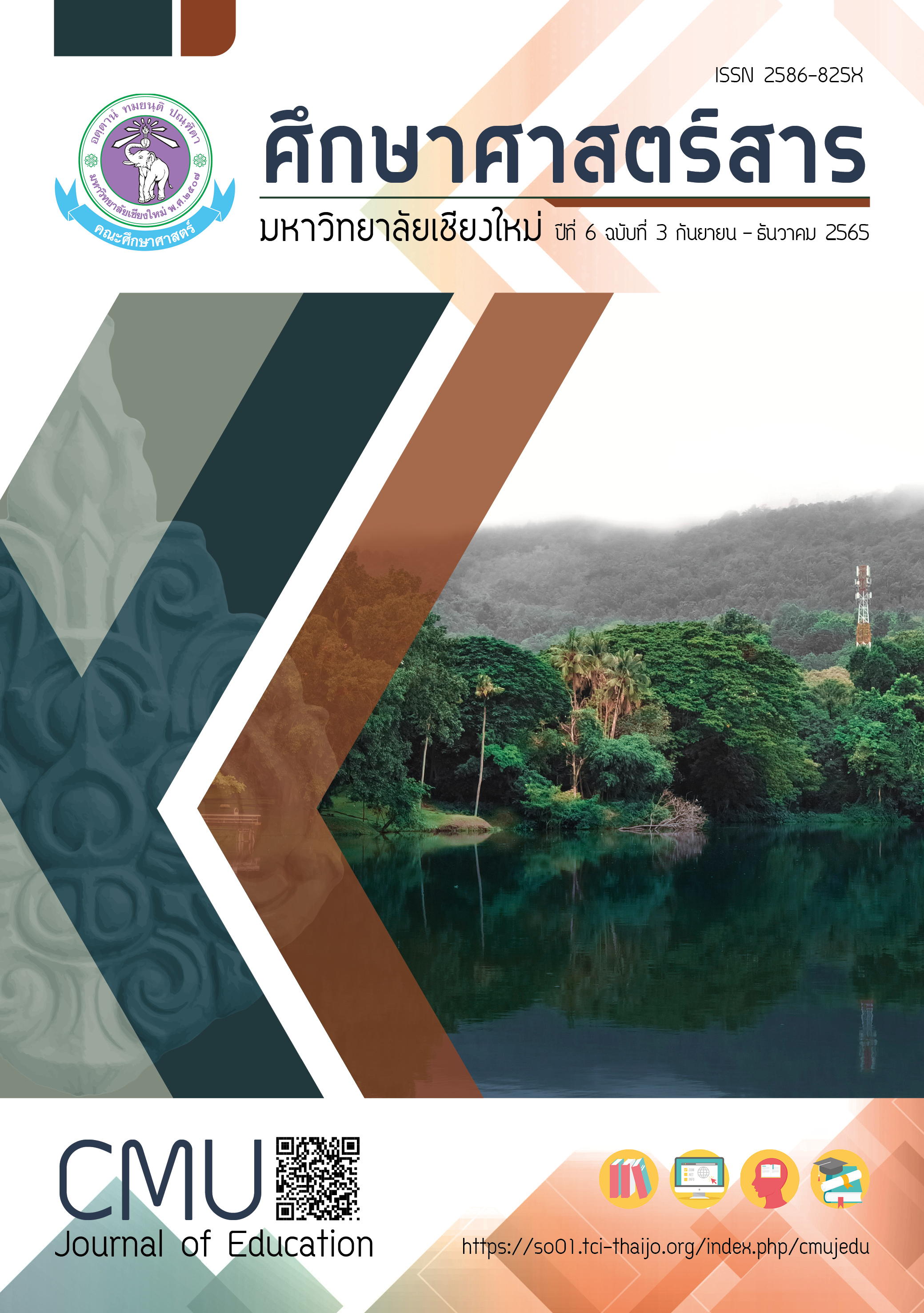“ห้องเรียนเสมอภาค” แนวคิดการจัดการเรียนรู้ที่ไม่ทิ้งใครไว้หลังห้อง
Main Article Content
บทคัดย่อ
แนวคิดการสร้างความเสมอภาคในระดับปฏิบัติการในชั้นเรียน หรือการสร้างห้องเรียนเสมอภาค (Equitable Classroom) เป็นแนวคิดในการลดความเหลื่อมล้ำทางการศึกษาที่เริ่มต้นจากจุดปฏิบัติการในห้องเรียนก่อนเป็นลำดับแรก โดยการส่งเสริมให้ผู้เรียนที่แตกต่างหลากหลายได้รับความสนใจ ไม่ถูกละเลยและสร้างตัวตนในห้องเรียนได้ เพื่อให้ผู้เรียนเกิดการเรียนรู้อย่างมีความหมายและสามารถพัฒนาตนเองตามศักยภาพที่แท้จริง ซึ่งแนวคิดนี้ได้รับความสนใจในประเทศ ต่าง ๆ ที่มีประชากรหลากหลายชาติพันธุ์ แต่สำหรับในประเทศไทยแนวคิดนี้ยังไม่แพร่หลายมากนักและยังไม่ได้รับการสนับสนุนเท่าที่ควร ทั้งนี้ ในห้องเรียนเสมอภาคนั้น นักเรียนทุกคนจะสามารถเข้าถึงหลักสูตรที่เหมาะสม เรียนรู้เนื้อหาวิชาที่เข้มข้นและท้าทาย มีปฏิสัมพันธ์ที่ดีระหว่างนักเรียนกับครูและปฏิสัมพันธ์ที่เท่าเทียมกันระหว่างนักเรียน ได้รับการยอมรับและเห็นคุณค่า รวมถึงสามารถนำเสนอผลการเรียนรู้ของตนเองได้อย่างหลากหลาย ดังนั้น ครูซึ่งเป็นผู้มีบทบาทสำคัญในระดับชั้นเรียน จึงควรมีพื้นฐานความเข้าใจเกี่ยวกับความสามารถทางปัญญาของนักเรียน รู้จักนักเรียนเป็นรายบุคคล สามารถปรับหลักสูตรและการจัดการเรียนรู้ให้เหมาะสม รวมทั้งสามารถสร้างการมีส่วนร่วมในชั้นเรียนได้อย่างเสมอภาคซึ่งจะเป็นการลดช่องว่างในชั้นเรียนและทำให้นักเรียนเกิดการเรียนรู้ไปพร้อมกันได้โดยไม่มีใครถูกทิ้งไว้หลังห้อง
Article Details

อนุญาตภายใต้เงื่อนไข Creative Commons Attribution-NonCommercial-NoDerivatives 4.0 International License.
หากผู้เสนอบทความมีความจำเป็นเร่งด่วนในการตีพิมพ์โปรดส่งลงตีพิมพ์ในวารสารฉบับอื่นแทน โดยกองบรรณาธิการจะไม่รับบทความหากผู้เสนอบทความไม่ปฏิบัติตามเงื่อนไขและขั้นตอนที่กำหนดอย่างเคร่งครัด ข้อมูลของเนื้อหาในบทความถือเป็นลิขสิทธิ์ของ Journal of Inclusive and Innovative Education คณะศึกษาศาสตร์ มหาวิทยาลัยเชียงใหม่
เอกสารอ้างอิง
กองทุนส่งเสริมความเสมอภาคทางการศึกษา. (2564). 5 นวัตกรรมตัวอย่างจากห้องเรียนเสมอภาค. เข้าถึงจาก https://www.eef.or.th/infographic-08-01-21/.
คณะกรรมการอิสระเพื่อการปฏิรูปการศึกษา (กอปศ.). (2563). รายงานเฉพาะเรื่องที่ 2 ความไม่เสมอภาคทางการศึกษา. เข้าถึงจาก https://www.thaiedreform.org/wp-content/uploads/2020/01/CommissionReport04.pdf.
ธนาชัย สุนทรอนันตชัย. (2560). ความเท่าเทียม ความเสมอภาค และความเป็นธรรมทางสังคม กับการจัดสวัสดิการสังคมของประเทศไทย The Equality, Equity and Social Justice with the Social Welfare of Thailand. วารสารวิชาการคณะนิติศาสตร์ มหาวิทยาลัยหัวเฉียวเฉลิมพระเกียรติ, 7(2), 52-65.
รัชวดี แสงมหะหมัด. (2560). ความเหลื่อมล้ำทางการศึกษา : คุณภาพสังคมที่คนไทยมองเห็น. วารสารรัฐศาสตร์และรัฐประศาสนศาสตร์, 8(1), 33-66.
วิจารณ์ พานิช. (2562ก). ห้องเรียนเสมอภาค. เข้าถึงจาก https://www.gotoknow.org/posts/660998.
วิจารณ์ พานิช. (2562ข). ปาฐกถาเรื่อง "วิญญาณครู แห่งศตวรรษที่ 21 โอกาสยิ่งใหญ่ของครูไทยยุคสมัย". เนื่องในโอกาสได้รับพระราชทานปริญญาดุษฎีบัณฑิตกิตติมศักดิ์ สาขาวิทยาการเรียนรู้และนวัตกรรมการศึกษา มหาวิทยาลัยธรรมศาสตร์. เข้าถึงจาก https://www.scbfoundation.com/stocks/media/files/5ilbwyjtc.pdf.
สำนักงานเลขาธิการสภาการศึกษา. (2563). สถิติการศึกษาของประเทศไทย ปีการศึกษา 2561-2562. กรุงเทพ: บริษัทพริกหวานกราฟฟิค จำกัด.
สำนักงานส่งเสริมสังคมแห่งการเรียนรู้และคุณภาพเยาวชน. (2557). ความไม่เท่าเทียมทางการศึกษา ภัยบั่นทอนปัญญาของชาติ. กรุงเทพ: สำนักงานส่งเสริมสังคมแห่งการเรียนรู้และคุณภาพเยาวชน.
องค์การยูนิเซฟ. (2562). ไร้เส้นกั้นการศึกษา : แนวปฏิบัติที่ดีและการถอดบทเรียนจากการจัดการศึกษา สําหรับเด็กข้ามชาติในประเทศไทย. กรุงเทพ: องค์การยูนิเซฟ ประเทศไทย.
Axinn, W. G., & Barber, J. S. (2001). “Mass Education and Fertility Transition”. American Sociological Review, 66(4), 481-505.
Berger, J. B., Cohen, B. P., & Zelditch, M., Jr. (1966). Status characteristics and expectation states. In J. Berger & M. Zelditch, Jr. (Eds.), Sociological theories in progress. Vol.1 (pp. 115 - 116). Boston: Houghton Mifflin.
Björnsson, J. K. (2020). Teaching Culturally Diverse Student groups in the Nordic Countries. In Frønes, T. S. (Eds.). Equity, Equality and Diversity in the Nordic Model of Education (pp. 75-98). Switzerland: Springer.
Center on Education Policy. (2006). From the capital to the classroom: Year 4 of the No Child Left Behind Act. Washington, DC: Center on Education Policy.
Cohen, E. & R. Lotan, (eds.). (1997). Working for equity in heterogeneous classrooms: Sociological Theory in Practice. New York: Teachers College Press.
Cohen, E. G. (1997). Understanding status problems: Sources and consequences. In E. G. Cohen & R. A. Lotan (Eds.). Working for equity in heterogeneous classrooms: Sociological theory in practice (pp. 61-76). New York: Teachers College Press.
Cohen, E. G. (2000). Equitable Classrooms in a Changing Society. In M.T. Hallinan (Eds.). Handbook of the sociology of education (pp. 265-283). New York: Springer-Verlag.
Cohen, E. G., & Lotan, R. A. (1997). Raising expectations for competence: The effectiveness of status interventions. In E. G. Cohen & R. A. Lotan (Eds.). Working for equity in heterogeneous classrooms: Sociological theory in practice (pp. 77-91). New York: Teachers College Press.
Eisner, E. W. (1991). What really counts in schools. Educational Leadership. (10–17). Retrieved from https://files.ascd.org/staticfiles/ascd/pdf/journals/ed_lead/el_199102_eisner.pdf.
Ellis, N., & Lotan, R. A. (1997). Teachers as learners: Feedback, conceptual understanding, and implementation. In E. G. Cohen & R. A. Lotan (Eds.). Working for equity in heterogeneous classrooms: Sociological theory in practice (pp. 209-222). New York: Teachers College Press.
Fainstein,S.S. (2010). The Just City. United States of America: Cornell University Press.
Garcia, E. E. (1993). Language, culture, and education. Review of Research in Education, 19, 51-98.
Harerimana, J. P. (2019). Equity Vs Equality: Facilitating Equity in the Classroom. International Journal of Research and Scientific Innovation (IJRSI), 6(11), 216 - 219.
Leal-Idrogo, A. (1997). The effect of gender on interaction, friendship, and leadership. In E. G. Cohen & R. A. Lotan (Eds.). Working for equity in heterogeneous classrooms: Sociological theory in practice (pp. 92-102). New York: Teachers College Press.
Lockheed, M. E., Harris, A., & Nemcef, W. P. (1983). Sex and social influence: Does sex function as a status characteristic in mixed-sex groups of children? Journal of Educational Psychology, 75, 877-866.
Lotan, R. (2006). Teaching Teachers to Build Equitable Classrooms. Theory Into Practice, 45(1), 8.
Montgomery County Public Schools. (2010). A Resource for Equitable Classroom Practices 2010. Retrieved from https://www.montgomeryschoolsmd.org/departments/development/resources/ecp/ ECP%20-%2008-13-10.pdf.
Nelson, Jack L., Carlson, Kenneth, Palonsky, Stuart B. (1996). Critical Issues in Education : A Dialectic Approach. Third Edition. New York: the McGraw-Hill.
Ridgeway, C. L., & Diekema, D. (1992). Are gender differences status differences? In C. L. Ridgeway (Ed.), Gender, interaction, and inequality (pp. 157-180). New York: Springer-Verlag.
Rosenholtz, S. J., & Simpson, C. (1984). The formation of ability conception: Developmental trend or social construction. Review of Educational Research, 54, 31-63.
The National Institute of Education Nanyang Technological University. (2016). Educational Equity. Retrieved from https://singteach.nie.edu.sg/wp-content/uploads/2016/03/SingTeach_issue56.pdf.
Turner, B. S. (1976). “Avineri's View of Marx's Theory of Colonialism: Israel”. Science and Society, 40(4), 385 - 409.
Van der Westhuizen, G. (2012). Learning equity in a University classroom. South African Journal of Higher Education, 26(3), 623-637.
Wood, E., Levinson, M., Postlethwaite, K. & Black, A. (2011). Equity Matters. Education International: University of Exeter. Retrieved from https://download.ei-ie.org/Docs/WebDepot/Equity%20 Matters.pdf.


